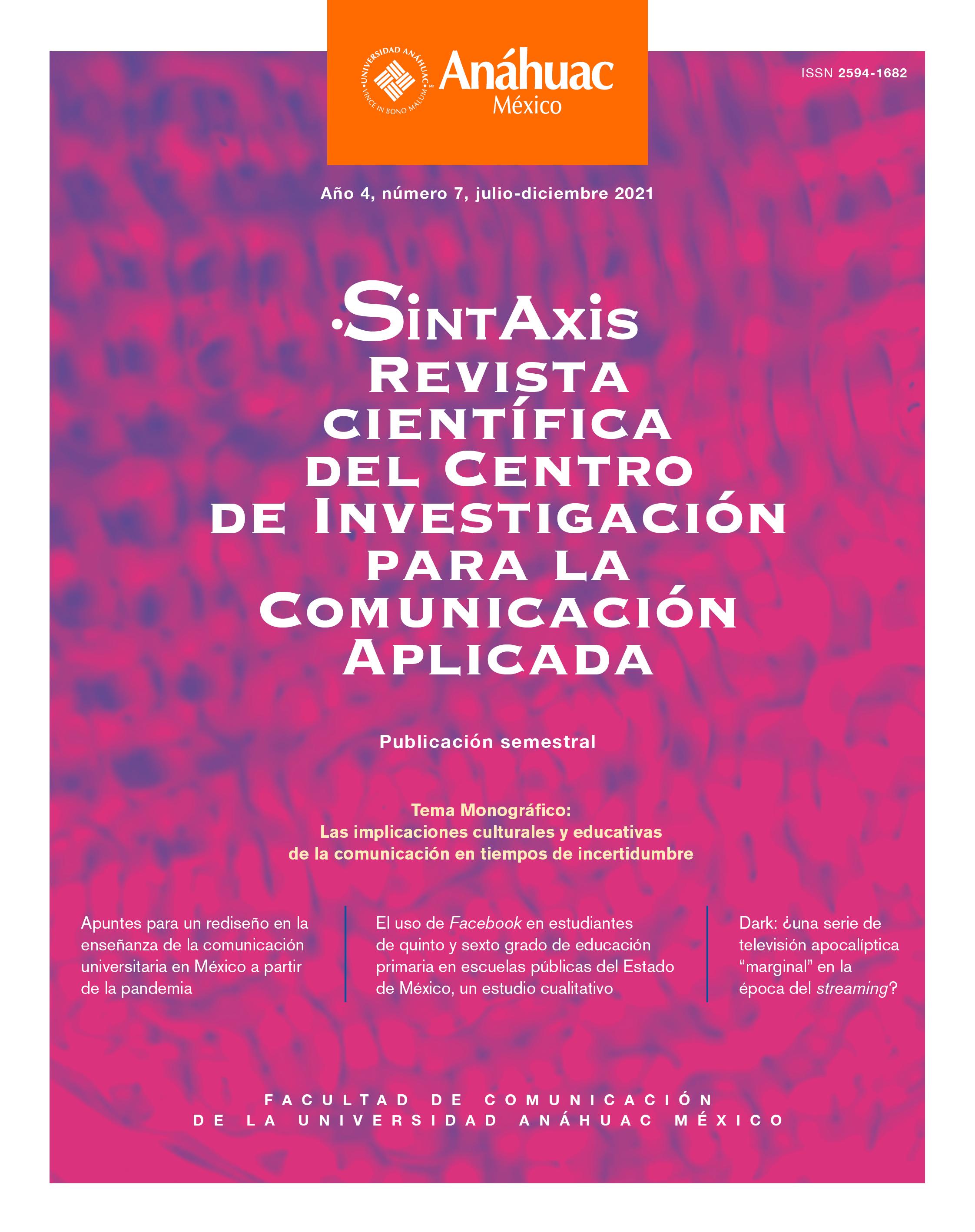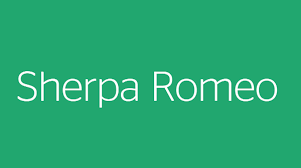Investigaciones anteriores al confinamiento por la COVID-19 sobre el uso de YouTube y los adolescentes
DOI:
https://doi.org/10.36105/stx.2021n7.08Palabras clave:
adolescentes, uso, mercadotecnia, identidad, consumo y apropiación, youtubers, youtubeResumen
Se presenta una investigación bibliográfica sobre la plataforma YouTube en relación con los adolescentes. Este estudio permitirá tener un punto de referencia del estado de la cuestión anterior a la COVID-19 para que investigaciones posteriores a la pandemia tengan un punto de referencia con respecto a los cambios en el uso de tecnologías digitales y la relevancia que en ellos tuvo el confinamiento. En este caso y en particular en referencia a dicha plataforma. La metodología consistió en la búsqueda de documentación en plataformas científicas, algunos repositorios y revistas indexadas de libre acceso así como su respectivo análisis por categorías metodológicas, temáticas y de origen geográfico. Los resultados muestran la variedad de temas tratados en torno a la relación entre los adolescentes y la plataforma YouTube. Entre 2015 y principio del 2020 se detectaron 54 trabajos relativos al tema en diferentes regiones. Se encontró un predominio de estudios cualitativos, originados mayoritariamente en España y en Estados Unidos. En México sólo se detectaron hasta el momento dos publicaciones. En términos generales la investigación sobre adolescentes usando YouTube se encuentra en un estado exploratorio y descriptivo.
Descargas
Referencias
Aran-Ramspott, S., Fedele, M., & Tarragó, A. (2018). Funciones sociales de los youtubers y su influencia en la preadolescencia. Comunicar, Revista Científica de Comunicación y Educación, 26(57), 71-80. https://doi.org/10.3916/C57-2018-07
Ardèvol, E., & Márquez, I. (2017). El youtuber como celebridad mediática: entre la autenticidad y el mercado. Rizoma, 5(2), 72-87. http://dx.doi.org/10.17058/rzm.v5i2.11288
Balakrishnan, J. y Griffith, M. D. (2017). Social media addiction: What is the role of content in YouTube? Journal of Behavioral Addictions, 6(3), 364–377. https://doi.org/10.1556/2006.6.2017.058
Balleys, C. (2017). L’incontrôlable besoin de contrôle: Les performances de la féminité par les adolescentes sur YouTube. Genre, sexualité & société. Recuperado de: http://gss.revues.org/3958
Balleys, C. (2018). Teen boys on YouTube, Representations of gender and intimacy. En R. Andreassen, R., M. Nebeling, K. Harrison & T. Raun (Eds.), Mediated Intimacies: Connectivities, Relationalities and Proximities (pp. 227-230). Londres: Routledge.
Bathia, A. (2018). Interdiscursive performance in digital professions: The case of YouTube tutorials. Journal of Pragmatics, 124, 106-120. https://doi.org/10.1016/j.pragma.2017.11.001
Berryman, R., & Kavka, M. (2018). Crying on YouTube: Vlogs, self-exposure and the productivity of negative affect. Convergence, 24(1), 85-98. https://doi.org/10.1177/1354856517736981
Blanco-Ruiz, M., & Sainz-de-Baranda, C. (2018). Channels produced by LGBT+ YouTubers:gender discourse analysis. Observatorio (OBS*) Journal, 97-121. https://doi.org/10.15847/obsOBS0001386
Calvelhe, L. (2019). Adolescentes gays en la era digital: orientaciones para la educación. Alteridad, Revista de Educación, 14(1), 65-75. https://doi.org/10.17163/alt.v14n1.2019.05
Cayari, C. (2015). Participatory culture and informal music learning through video creation in the curriculum. International Journal of Community Music, 8(1), 41–57. https://doi.org/10.1386/ijcm.8.1.41_1
De Bérail, P., Guillon, M., & Bungener, C. (2019). The relations between YouTube addiction, social anxiety and parasocial relationships with YouTubers: A moderated-mediation model based on a cognitive-behavioral framework. Computers in Human Behavior, 99, 190-204. https://doi.org/10.1016/j.chb.2019.05.007
Dynel, M. (2014). Participation framework underlying YouTube interaction. Journal of Pragmatics, 73, 37-52. https://doi.org/10.1016/j.pragma.2014.04.001
Elorriaga, A., & Monge, S. (2018). The professionalization of YouTubers: The case of Verdeliss and the brands. Revista Latina de Comunicación Social, (73), 37-54. https://doi.org/10.4185/RLCS-2018-1244en
Establés, M., Guerrero-Pico, M., & Contreras-Espinosa, R. (2019). Jugadores, escritores e influencers en redes sociales: procesos de profesionalización entre adolescentes. Revista Latina de Comunicación Social, (74), 214-236. https://doi.org/10.4185/RLCS-2019-1328
Fedele, M., Aran-Ramspott, S. y Suau, J. (2018). “I want to be a youtuber”. Online references and aspirational values for tweens. Trípodos, (43), 155-174. Recuperado de: https://www.raco.cat/index.php/Tripodos/article/viewFile/360636/452645
Fernández-de-Arroyabe-Olaortua, A., Lazkano-Arrillaga, I., & Eguskiza-Sesumaga, L. (2018). Nativos digitales: Consumo, creación y difusión de contenidos audiovisuales online. Comunicar, Revista Científica de Comunicación y Educación,, 26(57), 61-69. https://doi.org/10.3916/C57-2018-06
Fleck, B. K., Beckman, L. M., Sterns, J. L., & Hussey, H. D. (2014). YouTube in the classroom: Helpful tips and student perceptions. Journal of Effective Teaching, 14(3), 21-37.
García Jiménez, A., García, B., & López de Ayala, M. (2016). Adolescents and Youtube: Creation, participation and consumption. Prisma Social, 61-89. Recuperado de: http://www.redalyc.org/articulo.oa?id=353747311003
García, F., & Gil, F. J. (2018). ‘Youtubers’, mundos éticos posibles. index.Comunicación, index.Comunicación, 8(2), 151-188. Recuperado de:https://journals.sfu.ca/indexcomunicacion/index.php/indexcomunicacion/article/view/382
Gómez, P. N. (2014). Youtubers: fenómeno de la comunicación y vehículo de transmisión cultural para la construcción de identidad adolescente. Universidad de Cantábria. Recuperado de: http://hdl.handle.net/10902/4901
González, O. (2018). El video tutorial como herramienta de educación no formal en estudiantes de Bogotá, Colombia. Question/Cuestión, 1(59), 1-20. https://doi.org/10.24215/16696581e071
Hernández Sampieri, R., Fernández Collado, C. & Baptista Lucio, P. (1997). Metodología de la Investigación. México: McGraw Hill.
Hernández, M., & Andrade del Cid, P. (2020). Consumo cultural de adolescentes entre 15 y 18 años en YouTube: el caso de Xalapa, México. Revista Transdigital, 1(1), 1-22. Recuperado de: https://www.revista-transdigital.org/index.php/transdigital/article/view/14
Herrero-Diz, P., Ramos-Serrano, M., & Nó, J. (2016). Los menores como usuarios creadores en la era digital: del prosumer al creador colaborativo. Revisión teórica 1972-2016. Revista Latina de Comunicación Social, (71), 1301-1322. https://doi.org/10.4185/RLCS-2016-1147
Hidalgo-Marí, T. y Segarra-Saavedra, J. (2017). El fenómeno youtuber y su expansión transmedia. Análisis del empoderamiento juvenil en redes sociales. Fonseca, Journal Of Communication, (15), 43-56. http://dx.doi.org/10.14201/fjc2017154356
Klobas, J. E., McGill, T. J., Moghavvemi, S., & Paramanathan, T. (2018). Compulsive YouTube usage: A comparison of use motivation and personality effects. Computers in Human Behavior, 87, 129-139. https://doi.org/10.1016/j.chb.2018.05.038
Ko-Hsiu-Chia & Wen-Ning, W. (2017). Exploring the determinants of viewers’ loyalty toward beauty youtubers: A parasocial interaction perspective. Proceedings of 2017 International Conference on Education and Multimedia Technology (ICEMT 2017), 81-86. https://doi.org/10.1145/3124116.3124130
Kweon, Sang-Hee et al. (2020). Social media competition for user satisfaction: A niche analysis of Facebook, Instagram, YouTube, Pinterest, and Twitter. En T. Ahram (Ed.), Advances in Artificial Intelligence, Software and Systems Engineering. AHFE 2019. Springer, Cham. https://doi.org/10.1007/978-3-030-20454-9_24
Leon, L. (2018). Niños youtubers y el proceso de creación de videos: evidencia de competencias transmedia en acción. Comunicación y Sociedad, 16(33), 115-137. https://doi.org/10.32870/cys.v0i33.7080
Lindgren, S., & Lundström, R. (2019). Tube therapy: Dealing with mental health problems in social video comment threads. First Monday, 24(5). https://doi.org/10.5210/fm.v24i5.9569
Lobato, R. (2016). The cultural logic of digital intermediaries: YouTube multichannel networks. Convergence, 22(4), 348-360. https://doi.org/10.1177/1354856516641628
López, N., & Gómez, L. (2015). Análisis y proyección de los contenidos audiovisuales sobre jóvenes y drogas en YouTube. Estudios sobre el mensaje periodístico, 21(2), 863- 881. http://dx.doi.org/10.5209/rev_ESMP.2015.v21.n2.50889
Mahrt, M., & Bock, A. (2017). YouTube stars as role models for teenagers- display, affirmation, and negotiation of adolescent identities. paper for the annual conference of the International Communication Association (ICA), 2017, San Diego, CA.
Marone, V., & Rodriguez, R. C. (2019). “What’s so awesome with YouTube”: Learning music with social media celebrities. Online Journal of Communication and Media Technologies, 9(4), e201928. https://doi.org/10.29333/ojcmt/5955
Márquez, I. y Ardévol, E. (2018). Hegemonía y contracultura en el fenómeno youtuber Desacatos, Revista de Ciencias Sociales, (56), 34-49. https://doi.org/10.29340/56.1876
McRoberts, S., Bonsignore, E., Yarosh, S., & Peyton, T. (2016). "Do it for the viewers!": audience engagement behaviors of young youtubers. Paper presented at the Proceedings of IDC 2016 - the 15th International Conference on Interaction Design and Children, 334-343. http://dx.doi.org/10.1145/2930674.2930676
Montgomery, L., & Yockey, A. (2 de marzo de 2018 ). Rolling and scrolling: The portrayal of marijuana cigars (blunts) on YouTube. Journal of Substance Use, 23(4), 436-440. https://doi.org/10.1080/14659891.2018.1444108
Morris, M., & Anderson, E. (2015). ‘Charlie is so cool like’:Authenticity, popularity and inclusive masculinity on YouTube. Sociology, 49(6), 1200-1217. https://doi.org/10.1177/0038038514562852
Murolo, N. L., & Lacorte, N. (2015). De los bloopers a los youtubers. Diez años de Youtube en la cultura digital. Question/Cuestión, 1(45), 15-29. Recuperado de: https://perio.unlp.edu.ar/ojs/index.php/question/article/view/2407
Newberry, C., & Adame, A. (15 de mayo de 2019). 22 Estadísticas de You Tube esenciales para este año. Hootsuite. Recuperado de: https://blog.hootsuite.com/es/estadisticas-de-youtube/
Newberry, C., & Adame, A. (2 de febrero de 2021). 25 estadísticas de YouTube que pueden sorprenderte: edición 2021. Hootsuite. Recuperado de: https://blog.hootsuite.com/youtube-stats-marketers/
Oksanen, A., Hawdon, J., & Räsänen, P. (2014). Glamorizing rampage online: School shooting fan communities on YouTube. Technology in Society, 39, 55-67. http://dx.doi.org/10.1016/j.techsoc.2014.08.001
Pereira, S., Moura, P., & Fillol, J. (2018). El fenómeno de los youtubers: ¿qué hace que las estrellas de YouTube sean tan populares entre los jóvenes? Fonseca, Journal of Communication(17), 107-123. https://doi.org/10.14201/fjc201817107123
Pérez-Torres, V., Pastor-Ruiz, Y., & Abarrou-Ben-Boubaker, S. (2018). Los youtubers y la construcción de la identidad adolescente. Comunicar, Revista Científica de Comunicación y Educación, 26(55), 61-70. https://doi.org/10.3916/C55-2018-06
Phelps-Ward, R. J., & Crystal T, L. (2016). Talking back in cyberspace: self-love, hair care,and counter narratives in Black adolescent girls’ YouTube vlogs. Gender and Education, 28(6), 807-820. http://dx.doi.org/10.1080/09540253.2016.1221888
Ramírez-Ochoa, M. I. (2016). Posibilidades del uso educativo de YouTube. Ra Ximhai, 12(6), 537-546. Recuperado de: http://www.redalyc.org/articulo.oa?id=46148194036
Ramos-Serrano, M. y Herrero-Diz, P. (2016). Unboxing and brands: youtubers phenomenon through the case study of evantubehd. Revista Prisma Social, número especial 1: Teens and Ads, 90-120. Recuperado de: https://revistaprismasocial.es/article/view/1315
Regueira, U., Alonso-Ferreiro, A., & Da-Vila, S. (2020). La mujer en YouTube: Representación y participación a través de la técnica Web Scraping. Comunicar, Revista Científica de Comunicación y Educación, 63(2), 31-40. https://doi.org/10.3916/C63-2020-03
Riboni, G. (2013). Between professionalism and amateurship: Makeup discourse on YouTube. Lingue Culture Mediazioni, 4(1), 117-134. http://dx.doi.org/10.7358/lcm-2017-001-ribo
Romer, D., Jamieson, P. E. y Jamieson, K. H., Jones, C., & Sherr, S. (2017). Counteracting the influence of peer smoking on YouTube. Journal of Health Communication, 22(4), 337-345. https://doi.org/10.1080/10810730.2017.1290164
Schwemmer, C., & Ziewiecki, S. (2018). Social media sellout: The increasing role of product promotion on YouTube. Social Media + Society, 4(3), 1-20. https://doi.org/10.1177/2056305118786720
Scolari, C., & Fraticelli, D. (2017). The case of the top Spanish youtubers: Emerging media subjects and discourse practices in the new media ecology. Convergence: The International Journal of Research into New Media Technologies, 25(3), 496-515. https://doi.org/10.1177/1354856517721807
Shields, D. (2015). Girls’ ‘pain memes’ on YouTube: The production of pain and femininity in a digital network. En S. Baker, B. Robards, & Buttigieg, B. (2015), Youth Cultures and Subcultures: Australian Perspectives (pp. 173-182.), Routledge. https://doi.org/10.4324/9781315545998
Stokel-Walker, C. (2019). The dark psychology behind YouTube's success. New Scientist, 242(3227), 42-43. https://doi.org/10.1016/S0262-4079(19)30741-9
Syed-Abdul, S., Fernandez-Luque, L., Jian, W., Li, Y., Crain, S., Hsu, M., Wang, Y., Khandregzen, D., Chuluunbaatar, E., Nguyen, P., & Liou, D. (2013), Misleading health-related information promoted through video-based social media: Anorexia on YouTube. Journal of Medical Internet Research, 15(2), e30. https://doi.org/10.2196/jmir.2237
Van-Dijck, J. (2016). La cultura de la conectividad: Una historia crítica de las redes sociales. Buenos Aires: Siglo XX1.
Webedia, R. W. (6 de mayo de 2019). Analizando el perfil de los usuarios de YouTube. ReasonWhy: https://www.reasonwhy.es/actualidad/estudio-usuarios-youtube-webedia-2019
Westenberg, W. (2016). The influence of youtubers on teenagers. An overview of the influence Dutch youtubers have on their teenage viewers and to what extent this influence is good or bad. [Master Thesis, University of Twente]. https://essay.utwente.nl/71094/1/Westenberg_MA_BMS.pdf
Yarosh, S., Bonsignore, E., Mcroberts, S., & Peyton, T. (2016). YouthTube: Youth video authorship on YouTube and Vine. CSCW '16: Proceedings of the 19th ACM Conference on Computer-Supported Cooperative Work & Social Computing, 1423–1437. https://doi.org/10.1145/2818048.2819961
Publicado
Número
Sección
Licencia
Sintaxis. Revista científica del Centro de Investigación para la Comunicación Aplicada© se distribuye bajo una Licencia Creative Commons Atribución-NoComercial-SinDerivadas 4.0 Internacional.
El autor conserva los derechos patrimoniales sin restricciones y garantiza a la revista el derecho de ser la primera publicación del trabajo. El autor es libre de publicar en cualquier otro medio su artículo, como un repositorio institucional.


















